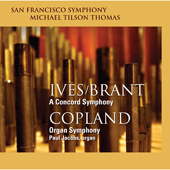
ESSENTIAL RECORDINGS

With his fabulous Mahler cycle now completed, conductor Michael Tilson Thomas moves on to another of his specialties, American composers. And good
for us that he opted for two often overlooked and neglected works from two of the most important and representative figures of American music. The Charles
Ives (1874-1954) A Concord Symphony (an orchestrated version by composer Henry Brant of Ives'
Piano Sonata No. 2, Concord, Mass., 1840-60, and the Aaron Copland (1900-1990) Organ Symphony (later
revised and re-orchestrated minus the organ as his Symphony No. 1).
In my opinion, the "Concord" Sonata by Charles Ives is a 20th century piano work so full of extra-musical content
and emotional associations with the spirit of early Americana, that the piano alone can't do it full justice. It needed the spectrum of colors and timbres of an orchestra
to fully bring out its true character. The Canadian born composer Henry Brant (1913-2008) envisioned just that and worked on its orchestral transcription
on and off for 36 years, in between his own compositions and earning a living. The connection and kinship between Ives and Brant goes way back, as both of them had
seen some of their early works published under the same New Music Society founded in 1926 by Henry Cowell, an association of composers whose more
reputable members included Ruggles, Crawford, Riegger, McPhee and Cage. So Brant's orchestration of the piano sonata not only retains Ives' signature, it reveals all of
its internal imagery and subtleties. It was concluded in 1994 and this seems to be the only available recording thus far, and a very atmospheric and persuasive one at that.
Visceral, primitive, savagely brutal, raw ... these are but a few of the words I would use to describe some segments of Aaron Copland's
Organ Symphony. A work that was premiered in 1925 by the New York Symphony Orchestra under the direction of Walter Damrosch who at the time told
the audience; "Ladies and gentlemen, I am sure you will agree that if a gifted young man can write a symphony like this at the age of 23, within five years he will
be ready to commit murder." That remark, I'm sure, was meant to prepare the audience for the onslaught of sound, the blitz of the full orchestra trying to
extinguish the massive power of the mighty pipe organ at the end. Add to that the many dark colors found in the main melodic material played by the organ, and you have
a piece of music that brings out strong emotions. Ever since hearing the Bernstein/Biggs recording in 1967, I've considered this work by Copland to be one of the landmarks
of 20th century music, and have often been accused of being off my rocker for that opinion. If I am not mistaking, I believe it was written as an exam submission for his
composition teacher Nadia Boulanger, and what a submission it is. It is not the 'wild wild west' or 'New York' Copland of later years, but some of the syncopated rhythms of the middle
movement and some harmonic inclinations already foretell the giant of American music he was to become. It is mostly formed by a European style most likely imposed by
the influence of his teacher at the time, with even a strong resemblence to the opening of Mahler's tenth symphony, at the start of the final movement. But jazz, and even
blues elements lurk within the shadows. Notice in particular the blues influenced solo organ lines within the Scherzo movement, and the beauty of the sound
produced by the entrance of the orchestra at the 4:15 mark of that movement is pure magic. In general throughout the work, the pipe organ is an integral part of the sound's fabric, but with its distinctive sound, shines
through like a candle in the dark, which again is very effective at setting an unsettling mood from start to finish. Paul Jacobs' playing is heartfelt and
well-balanced at all times, creating a seamless thematic flow between soloist and orchestra. The final movement is wonderful, with the opening three notes used as the
motivic basis for the whole movement. Some of the haunting melodic lines of the organ in this movement will linger in your mind long after hearing them. And here is
the arena in which the organ and orchestra battle for supremacy until the heavy blows of the full orchestra at the end, with brutal savagery, finally silence the mighty organ.
Both works were captured during 'live' performances at Davies Symphony Hall in San Francisco, and conductor Michael Tilson Thomas, organist
Paul Jacobs, and the San Francisco Symphony Orchestra members were all intent on creating what turned out to be two very memorable
evenings indeed. This Hybrid SACD recording delivers all the powerful energy of the music, with plenty of room to spare. Two rarities of this calibre on the same CD is
what I would classify as a definite must-have!
Jean-Yves Duperron - February 2011
CORRECTION: In the second paragraph of this review, I mention that this seems to be the only available recording of the Ives/Brant work. There is actually a previous
release that was recorded in 2000, with the Royal Concertgebouw Orchestra conducted by Dennis Russell Davies, on the Innova label (Innova 414). Thank you so much
to Kathy Wilkowski (wife of the late Henry Brant) for sharing this information with me and all the readers and collectors out there.